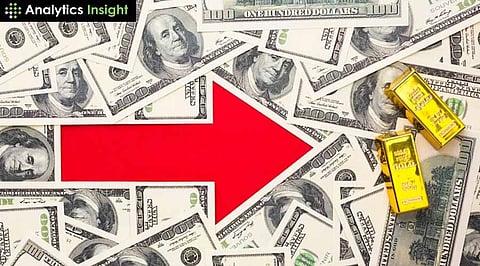

The global financial landscape continues to transform, with debates on gold vs. US dollar investment swirling. As of 2025, both assets have emerged as essential elements of any type of investment strategy.
The commodities have their own set of benefits and risks, with the US dollar holding a distinctiveness that makes it suitable for specific kinds of investors. Let’s explore current trends in the two investment tools, their functions within the world market, and the most influential factors affecting their performance.
Gold price in 2025 is approximately US$2,768 per ounce as of January 27, 2025. Spot prices have decreased by 0.1% from the previous trading session. US gold futures are trading 0.2 percent lower at US$2,772.70 per ounce. It has seen an increase of nearly 4.40% so far, up from US$115.39 in one ounce. However, overall, there is less buoyancy concerning sentiment as far as central banks' policies and geopolitical and inflationary conditions are concerned.
The US dollar is strong in 2025, having risen 0.2%. It directly hurts gold since a rising dollar makes the metal more expensive to foreign buyers. The Federal Reserve likely will maintain interest rates at 4.25% to 4.50% in its next two decisions, which may further affect both the dollar and gold prices.
The history of gold is a safe-haven asset, especially during an economic crisis. For instance, in 2024, its prices skyrocketed mainly because of rising geopolitical tensions as well as the increasing demand from the central banks, mainly in Asia.
Analysts forecast gold's price range within 2025 to lie within US$2,600-US$3,100 an ounce. Growth is stimulated in part due to the ongoing central bank buys. Interest rate cuts are further expected in the coming quarters by the Feds.
Central Bank Purchases: Gold purchases have increased by the Central banks of the world. More than 500 tonnes were purchased in 2024 alone. A rising trend is expected to continue as uncertainties across the globe gain pace.
Geopolitical Tensions: Conflicts and uncertainties prevail almost everywhere in the world. Related uncertainty always compels investors to prefer gold due to the ever-growing demand for this metal.
Hedge against Inflation: As fears of inflation rise, many are turning to gold as a hedge against eroding fiat currencies' purchasing power.
The historical record abounds regarding using gold as an asset during periods of economic distress. In periods of inflation and market crises, gold has tended to outperform most other asset classes. It is expected to do so again in 2025, thereby, providing a secure long-term investment for stability.
The dollar is the world's reserve currency and the most important asset in global markets. In early 2025, the dollar’s value has appreciated, primarily due to the risk-averse market sentiment and expectation that the Federal Reserve will continue its hawkish policy orientation. A high US dollar often goes along with good economic conditions, such as low unemployment rates and GDP growth. This will boost demand for dollar-denominated assets.
There are multiple reasons for the US dollar investment:
Liquidity: It is the world's most liquid currency. Thus, trading and converting the dollar is quite effortless.
Interest Rates: Due to higher interest rates, the assets denominated in dollars are seemingly more appealing and outperform other non-yielding assets, including gold.
Economic Growth: A strong US economy usually leads to greater investor confidence in the dollar. Thus, positively impacting the equity markets and other dollar-based investments.
Conversely, the US dollar is not free from risks. Inflation at high levels or geopolitical tensions are among those factors that would erode the value of the US dollar over time. If inflation is on the rise without interest rates rising, the real value of dollar-denominated assets would be lost.
Several important differences arise when comparing gold with the US dollar:
It is clear from the above table that a stable investment against economic uncertainty and inflation would be gold. However, the liquidity and growth in the United States economy made the US dollar sparkle, especially after Trump’s US presidential election win. A prudent investment for someone trying to find a balance between risk and return could be diversifying a portfolio of a mix of both assets.
Gold investments are perfect for those who want to invest safely and plan against the climbing inflation rates and volatile market conditions. Those with a relatively high-risk appetite and financial objectives can invest in the US dollar. It provides more liquidity and opportunities for higher returns from a strong economy. However, with this comes vulnerability to inflation as well as geopolitical factors. The global economic landscape is rapidly evolving in 2025. So, investors will need to consider the benefits and risks of each asset class, keeping their financial objectives in mind.
